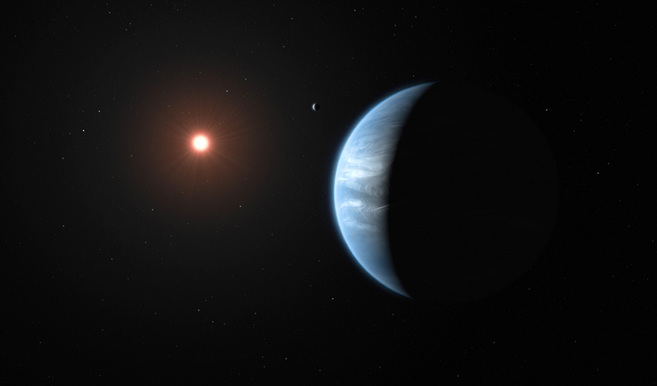- Habitability: Life in neighboring exoplanets is possible despite high radiation
- At 39 light years A solar system full of 'Lands'
After many years of searching, astrophysicists have found a planet outside our solar system that seems to have water and a mild climate, two conditions necessary to house some kind of life. Directly checking it will not be possible because it is far away, at 110 light years , but thanks to space telescopes scientists can find out some data such as the composition of its atmosphere or its size.
K2-18b , as this exoplanet is called, has been known since 2015 - Spanish scientists of the CARMENES project, among others, studied some of its characteristics - but it has been now when they have detected in its atmosphere water vapor, a discovery they have revealed this week in the journal Nature Astronomy .
Located in the constellation Leo, K2-18b has a mass eight times larger than that of the Earth and its atmospheric composition is quite different from that of our planet . The star that orbits is a red dwarf (called K2-18), a star very different from the Sun. It is not, therefore, a world similar to ours, but the combination of water and moderate temperatures make it a place in the that perhaps life could develop, according to the scientists who sign this study.
"Finding water in a potentially habitable world other than Earth is something incredibly exciting. K2-18b is not a 2.0 Earth, but it brings us a little closer to the moment when we can answer a fundamental question: Is Earth a unique world? ? ", reflects Angelos Tsiaras, a researcher at University College London and lead author of this study.
As exoplanet expert Guillem Anglada Escudé recalls, without linking to this study, " water vapor had previously been detected in some giant hot planets - so-called hot jupiters - but not in temperate worlds like this one."
The authors of this work used data obtained between 2016 and 2017 by the Hubble Space Telescope (from NASA and the European Space Agency) and developed algorithms to analyze the filtered light through the atmosphere of the planet K2-18b, discovered by the Kepler telescope. The results showed signs of water vapor in its atmosphere, in addition to a significant amount of hydrogen and also helium. Although they cannot specify their composition in detail, the models used indicate that up to 50% of the atmosphere of K2-18b could be water. Scientists also believe that there are probably nitrogen and methane molecules, but with the observations they have made they are not detectable.
For Anglada Escudé, from the Space Science Institute (Barcelona), if the presence of water vapor is confirmed, we are "definitely facing a planet and a very important result". However, he is cautious because he thinks that we will have to wait to do some more checks to make sure that the estimates made are correct. With the instruments of the future missions of the James Webb space telescope and ARIEL, the composition of their atmospheres can be studied better.
The question of its habitability is the most striking and complex. That it may have life does not mean that there is one, but if it did, the scientists believe that it would probably have to face a more hostile environment than Earth: it would be exposed to more radiation , since the dwarf star that orbits is very active. These types of stars, smaller than the Sun, are the most common in our galaxy. Planets the size of K2-18b are also the ones that seem most abundant. Worlds that have a mass of up to 10 times that of our planet (that is, greater than Earth's and inferior to Neptune's) are called super-earths .
Hundreds of super - earths have already been discovered and many more are expected to be added to the list in the coming years. But as Giovanna Tinetti, co-author of the study, points out, "there is little that is still known about its composition and nature. Looking at a large number of exoplanets, we hope to reveal the secrets about its chemistry, training and evolution," says the Italian scientist, who believes that K2-18b will be one of the most interesting objectives to which they will aim.
According to the criteria of The Trust Project
Know more- Science and Health
- science
SpaceTwo parachute failures threaten to postpone the ExoMars mission to Mars
TrafficThe elephant, against the ropes also for the legal sale of ivory
EnvironmentForest fires in Brazil increase by 83% due to deforestation and drought in the Amazon

